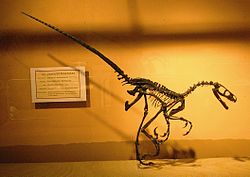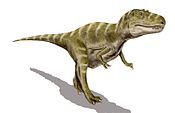- Dinosaur diet and feeding
-
Dinosaur diets and feeding behavior varied widely throughout the clade, including carnivorous, herbivorous, and omnivorous forms.
Contents
Ornithopoda
Hadrosauridae
Main article: Hadrosaur dietWhile studying into the chewing methods of hadrosaurids in 2009, the paleontologists Vincent Williams, Paul Barrett, and Mark Purnell found that hadrosaurs likely grazed on horsetails and vegetation close to the ground, rather than browsing higher-growing leaves and twigs. This conclusion was based upon the evenness of scratches on hadrosaur teeth, which suggested the hadrosaur used the same series of jaw motions over and over again.[1] As a result, the study determined that the hadrosaur diet was probably made of leaves and lacked the bulkier items such as twigs or stems, which might have required a different chewing method and created different wear patterns.[2] However, Purnell said these conclusions were less secure than the more conclusive evidence regarding the motion of teeth while chewing.[3]
The hypothesis that hadrosaurs were likely grazers rather than browsers appears to contradict previous findings from preserved stomach contents found in the fossilized guts in previous hadrosaurs studies.[3] The most recent such finding before the publication of the Purnell study was conducted in 2008, when a team led by University of Colorado at Boulder graduate student Justin S. Tweet found a homogeneous accumulation of millimeter-scale leaf fragments in the gut region of a well-preserved partially-grown Brachylophosaurus.[4][5] As a result of that finding, Tweet concluded in September 2008 that the animal was likely a browser, not a grazer.[5] In response to such findings, Purnell said preserved stomach contents are questionable because they do not necessarily represent the usual diet of the animal. The issue remains a subject of debate.[6]
Coprolites (fossilized droppings) of some Late Cretaceous hadrosaurs show that the animals sometimes deliberately ate rotting wood. Wood itself is not nutritious, but decomposing wood would have contained fungi, decomposed wood material and detritus-eating invertebrates, all of which would have been nutritious.[7]
Theropoda
Tyrannosaur tooth marks are the most commonly preserved feeding traces of carnivorous dinosaurs.[8] It is usually not possible to identify tooth marks on bone made by small predatory dinosaurs due to similarities in the denticles on their teeth.[8] However there are exceptions, like an ornithomimid caudal vertebra that has tooth drag marks attributed to Saurornitholestes and a partial Troodon skeleton with preserved puncture marks.[8] Small bones of small theropods that were preyed upon by larger ones may have been swallowed whole and digested frequently enough to affect their abundance in the fossil record.[9]
In 2001, Bruce Rothschild and others published a study examining evidence for stress fractures in theropod dinosaurs and the implications for their behavior.[10] Since stress fractures are caused by repeated trauma they are more likely to be a result of the animal's behavior than fractures obtained during a single injurious event.[11] The distribution of stress fractures also has behavioral significance.[12] Stress fractures to the hand are more likely to result from predatory behavior since injuries to the feet could be obtained while running or migrating.[12] In order to identify stress fractures occurring in the feet of Allosaurus specifically due to predatory behavior, the researchers checked to see if the toes which bore the greatest stress while in motion also had the greatest percentage of stress fractures.[13] Since the lower end of the third metatarsal would contact the ground first while a theropod was running it would have borne the most stress and should be most predisposed to suffer stress fractures.[13] The lack of such a bias in the examined fossils indicates an origin for the stress fractures from a source other than running, like interaction with prey.[13] They suggested that such injuries could occur as a result of the allosaur trying to hold struggling prey with its feet.[13] Contact with struggling prey is also the likely cause of tendon avulsions found in the forelimbs of Allosaurus and Tyrannosaurus.[13] The authors concluded that the presence of stress fractures provide evidence for "very active" predation-based diets rather than obligate scavenging.[10]
Allosaurus
In 2001, Bruce Rothschild and others published a study examining evidence for stress fractures in theropod dinosaurs and the implications for their behavior.[10] Since stress fractures are caused by repeated trauma they are more likely to be a result of the animal's behavior than fractures obtained during a single injurious event.[11] The distribution of stress fractures also has behavioral significance.[12] Stress fractures to the hand are more likely to result from predatory behavior since injuries to the feet could be obtained while running or migrating.[12] In order to identify stress fractures occurring in the feet of Allosaurus specifically due to predatory behavior, the researchers checked to see if the toes which bore the greatest stress while in motion also had the greatest percentage of stress fractures.[13] Since the lower end of the third metatarsal would contact the ground first while a theropod was running it would have borne the most stress and should be most predisposed to suffer stress fractures.[13] The lack of such a bias in the examined fossils indicates an origin for the stress fractures from a source other than running, like interaction with prey.[13] They suggested that such injuries could occur as a result of the allosaur trying to hold struggling prey with its feet.[13] Contact with struggling prey is also the likely cause of tendon avulsions found in the forelimbs of Allosaurus.[13] The authors concluded that the presence of stress fractures and tendon avulsions provided evidence for a "very active" predation-based diet rather than obligate scavenging in Allosaurus.[10]
Tyrannosauridae
Tyrannosaur tooth marks are the most commonly preserved feeding traces of carnivorous dinosaurs.[8] They have been reported from ceratopsians, hadrosaurs and other tyrannosaurs.[8] Tyrannosaurid bones with tooth marks represent about 2% of known fossils with preserved tooth marks.[8] Tyrannosaurid teeth were used as holdfasts for pulling meat off a body, rather than knife-like cutting functions.[14] Tooth wear patterns hint that complex head shaking behaviors may have been involved in tyrannosaur feeding.[14]
In 2001, Bruce Rothschild and others published a study examining evidence for stress fractures and tendon avulsions in theropod dinosaurs and the implications for their behavior.[10] Since stress fractures are caused by repeated trauma they are more likely to be a result of the animal's behavior than fractures obtained during a single injurious event.[11] The distribution of stress fractures also has behavioral significance.[12] Stress fractures to the hand are more likely to result from predatory behavior since injuries to the feet could be obtained while running or migrating.[12] The researchers concluded that contact with struggling prey is the likely cause of a tendon avulsion found in the forelimb of the Tyrannosaurus specimen Sue.[13] The authors concluded that the presence of stress fractures in theropods provide evidence for "very active" predation-based diets rather than obligate scavenging.[10]
Saurornitholestes preyed upon by juvenile tyrannosaur
 Saurornitholestes skeleton.
Saurornitholestes skeleton.
A. R. Jacobsen published a description of a dentary referred to Saurornitholestes with tooth marks.[15] The dentary is about 12 cm long and preserves fifteen tooth positions, ten of these have teeth, with five of those teeth fully erupted and intact, two broken but functional as evidenced by the presence of wearfacets, three are only partially erupted.[16] Three toothmarks were visible on the lingual surface of the dentary.[16] Two of the three marks are series of grooves made by the serrations on the maker's teeth.[16]
The first consists of 6-7 parallel grooves within a 4 x 1.3 mm area beneath the alveolus of the third tooth and angled at forty-five degrees to the dentary's longitudinal axis.[16] The striations are between .37 mm and .40 mm thick with cuboidal cross-sections.[17]
 Gorgosaurus may have inflicted the tooth marks on the Saurornitholestes skull.
Gorgosaurus may have inflicted the tooth marks on the Saurornitholestes skull.
The second tooth mark lies between the fifth and sixth alveoli and consists of two smaller grooves separated 1.8 and 1.6 mm respectively from a larger central groove, with a V-shaped groove beneath it at an angle of sixty degrees to the longitudinal axis of the jaw.[17] The third mark consists of four parallel grooves in a 2 x 2 mm area on the seventh tooth oriented at ninety degrees to the longitudinal axis of the tooth.[17]
The shape of the preserved serrations are too different from those of Saurornitholestes for the marks to be the result of injuries incurred during intraspecific face biting behaviors.[18] Although the right shape for Dromaeosaurus tooth serrations, the preserved marks are too coarse to have been left by that genus.[18] Although a specific identification cannot be made, the most likely perpetrator would be a juvenile individual of one of the Dinosaur Park Formation's tyrannosaurids, like Gorgosaurus, Daspletosaurus, or Aublysodon.[9] Jacobsen determined that all of the marks on the jawbone were left by the same animal because the serration marks all share the same morphology.[18]
Dromaeosauridae
Saurornitholestes
An ornithomimid caudal vertebra has been discovered that has tooth drag marks attributed to Saurornitholestes.[8]
Footnotes
- ^ Williams, Vincent S.; Barrett, Paul M.; and Purnell, Mark A. (2009). "Quantitative analysis of dental microwear in hadrosaurid dinosaurs,and the implications for hypotheses of jaw mechanics and feeding". Proceedings of the National Academy of Sciences 106 (27): 11194–11199. doi:10.1073/pnas.0812631106. PMC 2708679. PMID 19564603. http://www.pubmedcentral.nih.gov/articlerender.fcgi?tool=pmcentrez&artid=2708679.
- ^ Bryner, Jeanna (2009-06-29). "Study hints at what and how dinosaurs ate". LiveScience. http://www.livescience.com/animals/090629-dino-teeth.html. Retrieved 2009-06-03.
- ^ a b Boyle, Alan (2009-06-29). "How dinosaurs chewed". MSNBC. http://cosmiclog.msnbc.msn.com/archive/2009/06/29/1981788.aspx. Retrieved 2009-06-03.
- ^ Tweet, Justin S.; Chin, Karen; Braman, Dennis R.; and Murphy, Nate L. (2008). "Probable gut contents within a specimen of Brachylophosaurus canadensis (Dinosauria: Hadrosauridae) from the Upper Cretaceous Judith River Formation of Montana". PALAIOS 23 (9): 624–635. doi:10.2110/palo.2007.p07-044r.
- ^ a b Lloyd, Robin (2008-09-25). "Plant-eating dinosaur spills his guts: Fossil suggests hadrosaur's last meal included lots of well-chewed leaves". MSNBC. http://www.msnbc.msn.com/id/26893497/ns/technology_and_science-science/. Retrieved 2009-06-03.
- ^ This information comes from the aforementioned Alan Boyle source from June 29, 2009. However, this specific information is not included in the body of the article, but rather a response by Boyle to comments in the article. Since the comments were written by Boyle himself, and since they cite information he received specifically from Purnell, they are as legitimate a source of information as the article itself.
- ^ Chin, K. (September 2007). "The Paleobiological Implications of Herbivorous Dinosaur Coprolites from the Upper Cretaceous Two Medicine Formation of Montana: Why Eat Wood?". PALAIOS 22 (5): 554. doi:10.2110/palo.2006.p06-087r. http://www.bioone.org/perlserv/?request=get-document&doi=10.2110%2Fpalo.2006.p06-087r. Retrieved 2008-09-10.
- ^ a b c d e f g "Introduction," Jacobsen (2001). Page 59.
- ^ a b "Discussion," Jacobsen (2001). Page 61.
- ^ a b c d e f "Abstract," Rothschild, et al., et al. (2001); page 331.
- ^ a b c "Introduction," in Rothschild, et al. (2001); pages 331-332.
- ^ a b c d e f "Introduction," Rothschild, et al. (2001); page 332.
- ^ a b c d e f g h i j k "Discussion," Rothschild, et al. (2001); page 334.
- ^ a b "Introduction," in Abler (2001). Page 84.
- ^ "Abstract," Jacobsen (2001). Page 58.
- ^ a b c d "Description," Jacobsen (2001). Page 59.
- ^ a b c "Description," Jacobsen (2001). Page 60.
- ^ a b c "Discussion," Jacobsen (2001). Page 60.
References
- Abler, W.L. 2001. A kerf-and-drill model of tyrannosaur tooth serrations. p. 84-89. In: Mesozioc Vertebrate Life. Ed.s Tanke, D. H., Carpenter, K., Skrepnick, M. W. Indiana University Press.
- Jacobsen, A.R. 2001. Tooth-marked small theropod bone: An extremely rare trace. p. 58-63. In: Mesozioc Vertebrate Life. Ed.s Tanke, D. H., Carpenter, K., Skrepnick, M. W. Indiana University Press.
- Rothschild, B., Tanke, D. H., and Ford, T. L., 2001, Theropod stress fractures and tendon avulsions as a clue to activity: In: Mesozoic Vertebrate Life, edited by Tanke, D. H., and Carpenter, K., Indiana University Press, p. 331-336.
Categories:- Dinosaurs
Wikimedia Foundation. 2010.
